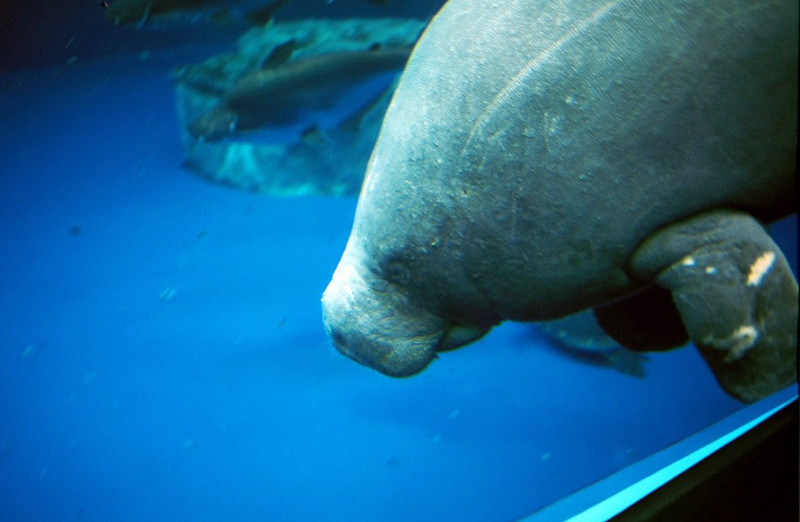African Manatee Facts
- Perhaps the most notable thing about the amazing African Manatee remains the simple fact that researchers do not know a great deal about the animal. The majority of experts believe this distinctive animal to be quite similar to a related species.
- Since both of the species share the same region, one is often mistaken for the other. Yet, it actually represents one of only three species in its particular genus. Unfortunately, for several reasons, the creature lists as Vulnerable with the IUCN.
- Principle among these is the fact that poachers often prey on the species for its oil, bones, meat, and skin. Habitat loss due to urban expansion and agriculture additionally threaten it as well. Its estimated population numbers fewer than 15,000 individuals.
- The perils this work of evolution faces don’t simply end there, though. That’s due to the fact that it also faces the looming threat of ongoing climate change. In that respect, at least, it’s just like the great majority of other species around the world.
- The impressive African Manatee remains at an increased risk from these, and other threats, due to its already sparse population. Fortunately, it holds a protected status in all areas it inhabits. But sadly, this status is not strictly enforced in much of its range.
Related Articles
West Indian Manatee
African Manatee Physical Description
This wonder stands out for several reasons. For one, the fascinating African Manatee constitutes the second largest of all known varieties of this wonderful mammal. Only the equally remarkable creature known as West Indian Manatee attains a larger average size.
It further follows a pattern set by its kin. That’s true since it also displays only a small degree of the physiological characteristic of sexual dimorphism. In its case, this trait manifests itself in terms of size. More precisely, females tend to be slightly larger in that respect.
Overall, individuals of the remarkable species attain an average body length measuring between 10 – 13 ft (3 – 4 m). Nevertheless, exceptional specimens do occasionally occur, of course. These rare specimens sometimes reach a length of as much as 15 ft (4.6 m).
The African Manatee also grows quite heavy. Its maximum measured weight equals about 1,100 lb (500 kg). But again, most individuals remain much smaller than this. Size alone, though, does not represent the only remarkable physical characteristic this creature displays.
Intriguingly, the torpedo-shaped body it develops typically develops widest in the middle, creating a striking image. Meanwhile, its highly flattened tail closely resembles a large paddle. Its skin generally displays a dark gray color, and has a thin covering of fine hairs.
- Kingdom: Animalia
- Phylum: Chordata
- Class: Mammalia
- Order: Sirenia
- Family: Trichechidae
- Genus: Trichechus
- Species: T. senegalensis
African Manatee Distribution, Habitat, and Ecology
The African Manatee seems to live exclusively along a particular portion of the coastline of western Africa. That apparent range includes the coastlines of a total of 19 countries. Within this range, however, the animal appears to inhabit each region fairly equally.
But, the known distribution of the mammal remains comparatively sparse. The marvelous animal also only appears to inhabit a very narrow range of depths. That’s partly because the Sirenian only extends it range out to a distance of about 47 mi (75 km) from the shore.
Within that restricted range, it mostly inhabits regions of coastal flats and mangrove forests. Showing its adaptability, however, it also inhabits several inland lakes. Beyond that, the creature even appears occasionally in such brackish waters as lagoons and estuaries.
But areas of calm water appear to be its preferred habitat. The animal also rarely lives in waters with a temperature of less than 64.4 F (18C). This affects its diet, as well. Its dietary habits remain primarily the same as related species, with one notable exception.
Most Sirenians only consume non-plant material when necessary for survival. But the African Manatee seems to intentionally seek it out. This mainly consists of clams, mollusks, and fish it finds in nets. It still feeds primarily on plants along the shoreline, or hanging over.
It also evolved as primarily nocturnal in nature. During periods of inactivity, it typically sleeps in shallow waters of no more than 3 -6 ft ( 1- 2 m) deep. It also breeds throughout the year, with a female usually giving birth every 3 – 5 years. It’s thought to live roughly 30 years.
Species Sharing Its Range
Check out our other articles on North American Gulches and Canyons, Harpy Eagle, McMurdo Dry Valleys, Jackfruit Tree, Tiger Rattlesnake, Striped Possum, Orange-belted Bumblebee

